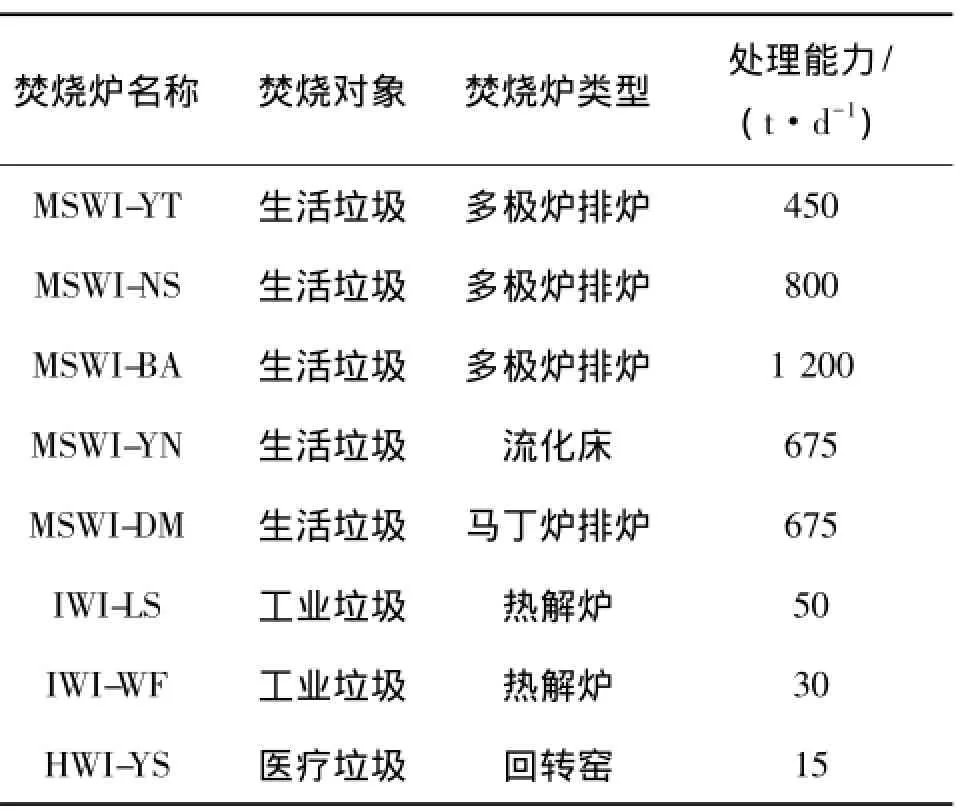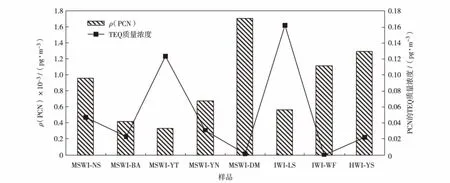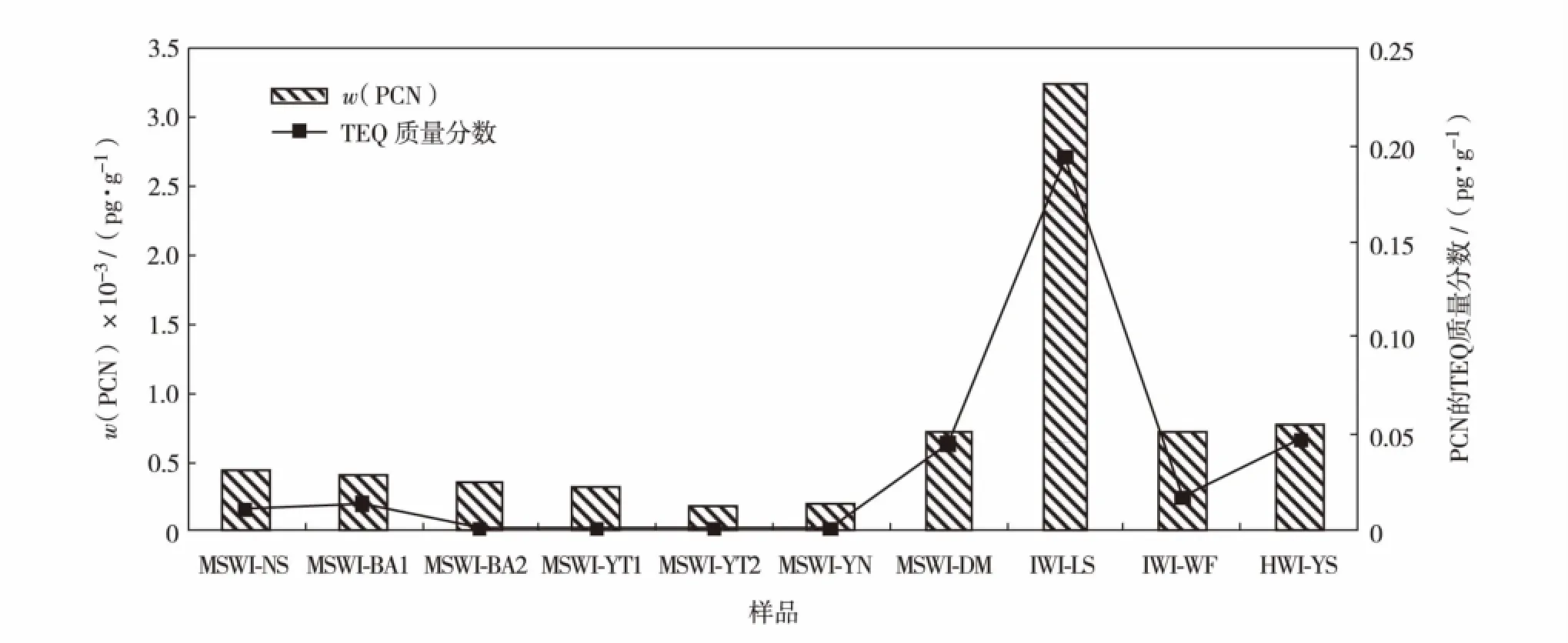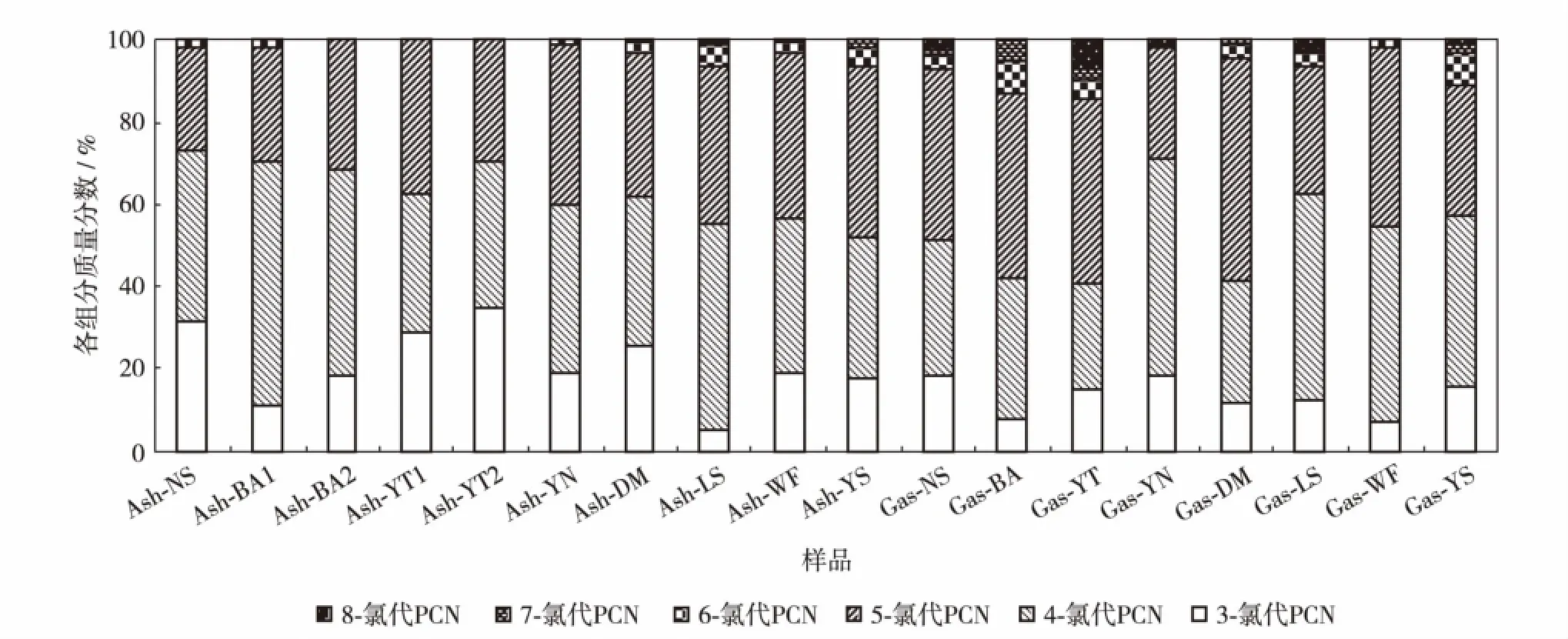垃圾焚烧炉飞灰和烟气中多氯化萘的分布特征
2015-12-24
垃圾焚烧炉飞灰和烟气中多氯化萘的分布特征
刘国卿1,2,刘德全3,周志华3
1)深圳大学核技术应用研究所,深圳518060; 2)中国科学院广州地球化学研究所,广州510640;
3)深圳市环境监测中心站,深圳518049
摘要:分析深圳市生活垃圾、医疗废弃物和危险废弃物焚烧炉排放飞灰及烟道气中多氯化萘(polychlorinated naphthalene,PCN)的污染特征.结果发现,垃圾焚烧炉排放飞灰和烟道气中PCN的质量分数为0.18~3.30 ng/g(平均0.73 ng/g;干质量(dry weight,dw) )和质量浓度0.33~1.70 ng/m3(平均0.87 ng/m3,dw).医疗废弃物和工业废弃物焚烧炉中的PCN含量普遍高于生活垃圾焚烧炉,飞灰和烟道气中排放的PCN主要以3-氯取代化合物—5-氯取代化合物为主,其中,CN23、CN28/CN43、CN35、CN38/CN40、CN46、CN61、CN57、CN62和CN59是最主要的化合物.
关键词:大气污染;环境监测;垃圾焚烧炉;飞灰;烟气;多氯化萘;来源解析
Received: 2015-05-27; Accepted: 2015-06-04
Foundation: National Natural Science Foundation of China(41102217) ; Earmarked Found of the State Key Laboratory of Organic Geochemistry(OGL-201207)
Corresponding author: Professor Liu Dequan.E-mail: dqnliu@ tom.com
Citation: Liu Guoqing,Liu Dequan,Zhou Zhihua.Polychlorinated naphthalene distribution in fly-ash and flue gas from waste incinerator[J].Journal of Shenzhen University Science and Engineering,2015,32(4) : 398-403.(in Chinese)
多氯萘(polychlorinated naphthalene,PCN)是一类物化性质与多氯联苯(polychlorinated biphenyl,PCB)相似的工业化学品,由于具有良好的热稳定性、电绝缘性和阻燃性等,被广泛用于电容器和变压器绝缘油、阻燃剂和油漆添加剂中.目前,环境中的PCN主要来自早期产品在使用过程中的遗弃、泄露和排放,以及人类生产活动过程无意产生,如水泥生产、金属冶炼、废弃物焚烧等热过程[1-2].
废弃物焚烧处理由于具有资源化、减量化和无害化的优点,已逐渐成为中国城市垃圾处理的主要方式之一.然而,废弃物焚烧过程中不可避免地会产生大量的污染物,如粉尘、酸性气体和重金属等,也包括大量的持久性有机污染物(persistent organic pollutant,POP),如多环芳烃、多氯联苯、多氯化萘以及二恶英/呋喃等.近年来,人们对废弃物焚烧所产生多环芳烃、多氯联苯和二恶英的研究取得了很大的进展[3-4],然而有关废弃物焚烧排放PCN的报道却甚少[5-7].深圳市是我国最早实施垃圾焚烧发电试点城市,目前已建和在建的大型垃圾发电厂共10座,是我国垃圾焚烧发电厂最为密集的地区.PCN的源成分谱特征是进行污染物来源解析的重要基础数据.本研究对深圳市不同垃圾焚烧炉飞灰和烟气进行采样分析,以期获得废弃物焚烧过程中排放的PCN污染特征,为环境中POP污染物的来源判识提供依据.
1 材料与方法
1.1样品采集
选择深圳市不同类型废弃物焚烧炉(表1),分别收集除尘器捕集的飞灰样品,利用意大利Tecora烟气采样器采集烟道气样品.利用石英纤维滤膜(孔径为85 mm)采集烟道气颗粒物样品,利用XAD-2树脂采集收集气相样品,采样完成后,取出滤膜和XAD-2树脂,放入干净的棕色玻璃瓶,用聚四氟乙烯塞盖紧两端,并用锡纸包裹玻璃筒,带回实验室冷冻保存,待分析.石英滤膜在采样之前于500℃烘焙5 h,密封备用; XAD-2树脂在使用前分别用丙酮-二氯甲烷混合溶剂(体积比为1∶1)提取24 h,真空干燥.

表1 焚烧炉及烟气样品采集信息表Table 1 Detailed information of waste incinerators and fly ash sample
1.2样品分析
称取约10 g飞灰样品,加入回收率指示物(2,4,5,6-tetrachloro-m-xylene,TCmX)、PCB209、13C-反式氯丹;然后用二氯甲烷索氏抽提.烟道气样品(滤膜+XAD-2树脂)加入回收率指示物,以二氯甲烷为溶剂,超声萃取2次,每次溶剂用量为100 mL,超声30 min.样品提取物经多层硅胶-氧化铝复合柱(分离柱内径10 mm,从下至上分别为6 cm的中性氧化铝、2 cm的中性硅胶、5 cm的碱性硅胶、2 cm的中性硅胶、8 cm的酸性硅胶和1 cm的无水硫酸钠)分离净化,后旋转蒸发氮吹浓缩至约40 μL,加入五氯硝基苯(pentachloronitrobenzene,PCNB)内标物,待测.
PCN分析通过Agilent 7890 GC-MSD完成,采样用电子俘获负离子化源(electron capture negative ionization,ECNI)和选择离子扫描模式(selected ion monitoring,SIM)检测.色谱柱为DB-5ms(30 m×0.25 mm×0.25 μm),色谱升温程序为: 80℃下保留30 s,然后以15℃/min升至160℃,再以3 ℃/min的速率升至240℃,最后以6℃/min的速率升至280℃并保留10 min,载气为高纯氮,柱流速为1.2 mL/min,反应气为甲烷.采用Halowax1014定量,用单体的质量分数对结果进行校正.
1.3质量控制与质量保证
实验过程中的质量控制和质量保证体系参照文献[8-9].实验空白包括溶剂空白、流程空白和样品空白,各种空白试验均未检出所要测定的目标化合物; TCmX、PCB209和13C-反式氯丹的回收率范围分别为(76.0±11.0) %、(85.0±7.10) %和(81.8±12.5) %,样品结果未经回收率校正.
2 结果与讨论
2.1飞灰和烟道气中PCN的含量水平

图1 焚烧炉烟气样品中的PCN质量浓度及其TEQ质量浓度Fig.1 PCN mass concentrations and TEQ equivalent in stack gas samples from investigated waste incinerators

图2 焚烧炉飞灰样品中的PCN质量分数及其TEQ质量分数Fig.2 PCNs mass fractions and TEQ equivalent in fly ash samples from investigated waste incinerators
废弃物焚烧炉飞灰和烟道气中PCN含量分布见图1和图2.垃圾焚烧炉飞灰中PCN的质量分数为0.18~3.30 ng/g(平均为0.73 ng/g,干质量,dry weight,dw),垃圾焚烧炉烟气中PCN的质量浓度为0.33~1.70 ng/m3(平均为0.87 ng/m3,dw).根据Noma等[10]总结的PCN单体的2,3,7,8-tetrachlorodibenzo-p-dioxin(TCDD)相对效率因子,计算获得烟气和飞灰的PCN毒性当量(toxic equivalent,TEQ),烟气质量分数为0.001~0.193 pg/g(平均为0.033 pg/g,dw),飞灰质量浓度为0.002~0.123 pg/m3(平均为0.047 pg/m3,dw).由图1和图2可见,不同垃圾焚烧炉飞灰和烟气中PCN质量浓度和质量分数差异不明显,总体而言,医疗废弃物和工业废弃物焚烧炉中PCN含量略高于生活垃圾焚烧炉,其中,烟气样品中PCN质量分数最高的为生活垃圾焚烧炉MSWI-DM,而飞灰样品中质量浓度最高的是工业垃圾焚烧炉IWI-LS.Abad等[6]研究分析了西班牙垃圾焚烧炉排放的PCN水平,其1-氯取代PCN—8-氯取代PCN总的质量浓度为1.08~21.36 ng/m3,4-氯取代PCN—8-氯取代PCN总的质量浓度为0.33~5.72 ng/m3,PCN质量浓度水平与深圳市垃圾焚烧炉相当.相比而言,深圳市废弃物焚烧炉排放的PCN质量浓度远低于我国北方地区的垃圾焚烧炉.如Hu等[7]采集分析了北方地区9家垃圾焚烧厂27个烟气样品,PCN(1-氯取代PCN—8-氯取代PCN)的质量浓度为97.6~874 ng/m3; Tian等[11]报道了北方某焚烧炉烟气中PCN(1-氯取代PCN—8-氯取代PCN)的质量浓度为68.04~1 404.34 ng/m3.本研究未曾分析1-氯取代PCN—2-氯取代PCN化合物,因为这是北方一些垃圾焚烧炉排放PCN的主要化合物,约占PCN排放总量的90%[7].另外,由于南北方垃圾组成的差异以及垃圾焚烧方式的不同所致PCN排放的差异,具体原因尚待进一步分析研究.
2.2不同氯代PCN的分布特征
图3为废弃物焚烧炉飞灰和烟道气中不同氯代间的PCN分布特征.由图3可见,飞灰和烟道气中PCN的组分特征相似,且均以3-氯代PCN—5-氯代PCN化合物为主.Hu等[7]研究分析了我国北方地区废弃物焚烧炉烟气中PCN的分布特征,其PCN同系物主要以1-氯代PCN—4-氯代PCN化合物为主,有别于本研究结果.究其原因,是因为本研究未分析1-氯代的PCN—2-氯代的PCN.研究表明,不同的炉型如炉排炉或循环流化床,其多氯萘的分布也有所不同[12-13],但本研究未发现明显差异.

图3 废弃物焚烧飞灰和烟道气中不同氯代间的PCN分布特征Fig.3 Homologue profiles of PCNs in stack gas and fly ash samples from investigated waste incinerators
2.3 PCN同类物的分布特征
PCN的源成分谱特征是进行污染物来源解析的重要基础数据.早在20世纪80年代以前就已停止生产PCN,目前环境中的PCN多源于废弃物焚烧等热处理过程.Jarnberg等[14]发现CN52/CN60、CN66/CN67和CN73在飞灰样品中质量分数较其他单体有所增加;同时还发现一些单体(如CN39、CN44、CN48、CN54、CN60和CN70)在飞灰中含量较工业品PCN高出很多,可以作为燃烧来源的指示物.Schneider等[15]将飞灰的组成与工业用Halowax系列比较发现CN44、CN45/CN36、CN39、 CN38/CN48、CN51、CN54、CN66/CN67和CN73并不存在于PCN工业品Halowax里,可以作为焚烧源的指示物.图4为垃圾焚烧炉排放飞灰和烟气中PCN单体的质量分数.由图4可见,不论是飞灰和烟气样品,CN23单体均是质量分数/质量浓度最高的同类物,其余相对质量分数/质量浓度较高的同类物单体有CN28/CN43、CN35、CN38/40、CN46、CN61、CN57、CN62和CN59.有别于Liu等[16-17]的研究结果,作为焚烧特征来源的同类物单体CN52/CN60、CN66/CN67和CN73在本研究中的质量分数并不高.

图4 废弃物焚烧炉飞灰和烟道气中PCN单体的相对含量Fig.4 Relative contents of individual PCN homolog in stack gas and fly ash from investigated waste incinerators
结语
废弃物焚烧是环境中PCN的重要来源之一,本研究对深圳市废气物焚烧炉排放PCN的含量水平及污染特征进行了分析,研究结果可为环境中PCN的污染来源判识提供参考.
1)深圳市垃圾焚烧炉排放飞灰和烟气中PCN的质量浓度范围分别为0.18~3.30 ng/g(平均0.73 ng/g,dw)和0.33~1.70 ng/m3(平均0.87 ng/m3,dw),深圳市垃圾焚烧炉排放的PCN污染水平较内地其他地区低.
2)深圳市垃圾焚烧炉飞灰和烟气中的PCN主要以3-氯化合物—5-氯化合物为主,其对PCN总量的贡献为85.2%~98.4%,其中,CN23、CN28/CN43、CN35、CN38/CN40、CN46、CN61、CN57、CN62和CN59是最主要的化合物.
引文:刘国卿,刘德全,周志华.垃圾焚烧炉飞灰和烟气中多氯化萘的分布特征[J].深圳大学学报理工版,2015,32(4) : 398-403.
参考文献/References:
[1]Guo Li,Ba Te,Zheng Minghui.Study of sources and distribution characteristics of polychlorinated naphthalenes [J].Process in Chemistry,2009,21(2/3) : 377-388.(in Chinese)郭丽,巴特,郑明辉.多氯萘的研究[J].化学进展,2009,21(2/3) : 377-388.
[2]Guo Li.Studies on some sources of polychlorinated naphthalenes and its distributions in typical areas in China [D].Beijing: Research Center for Eco-Environmental Sciences,Chinese Academy of Sciences,2008.(in Chinese)郭丽.我国多氯萘的典型污染源解析及区域分布研究[D].北京:中国科学院生态环境研究中心,2008.
[3]Cheng Hefa,Hu Yuanan.Curbing dioxin emissions from municipal solid waste incineration in China re-thinking about management policies and practices[J].Environmental Pollution,2010,158(9) : 2809-2814.
[4]Jansson S,Lundin L,Grabic R.Characterisation and fingerprinting of PCBs in flue gas and ash from waste incineration and in technical mixtures[J].Chemosphere,2011,85(3) : 509-515.
[5]Falandysz J.Polychlorinated naphthalenes: an environmental update[J].Environmental Pollution,1998,101(1) : 77-90.
[6]Abad E,Caixach J,Rivera J.Dioxin like compounds from municipal waste incinerator emissions: assessment of the presence of polychlorinated naphthalenes[J].Chemosphere,1999,38(1) : 109-120.
[7]Hu Jicheng,Zheng Minghui,Liu Wenbing,et al.Characterization of polychlorinated naphthalenes in stack gas emissions from waste incinerators[J].Environmental Science Pollution Research,2013,20(5) : 2905-2911.
[8]Wang Yan,Cheng Zhineng,Li Jun,et al.Polychlorinated naphthalenes(PCNs) in the surface soils of the Pearl River Delta,South China Distribution,sources,and airsoil exchange[J].Environmental Pollution,2012,170: 1-7.
[9]Liu Guoqing,Liu Dequan,Li Zhigang,et al.Source and distribution of atmospheric polychlorinated biphenyls in Shenzhen[J].Journal of Shenzhen University Science and Technology,2014,31(4) : 421-427.(in Chinese)刘国卿,刘德全,李志刚,等.深圳市大气多氯联苯的分布特征与来源[J].深圳大学学报理工版,2014,31(4) : 421-427.
[10]Noma Y,Yamamoto T,Sakai S I,Congener-specific composition of polychlorinated naphthalenes,coplanar PCBs,dibenzo-p-dioxins,and dibenzofurans in the halowax series [J].Environmental Science&Technology,2004,38(6) : 1675-1680.
[11]Tian Zhenyu,Li Haifeng,Xie Huiting,et al.Concentration and distribution of PCNs in ambient soil of a municipal solid waste incinerator[J].Science of the Total Environment,2014(491/492) : 75-79.
[12]Iino F,Tsuchiya K,Imagawa T,et al.An isomer prediction model for PCNs,PCDD/Fs,and PCBs from municipal waste incinerators[J].Environmental Science &Technology,2001,35(15) : 3175-3181.
[13]Weber R,Iino F,Imagawa T,et al.Formation of PCDF,PCDD,PCB,and PCN in de novo synthesis from PAH: mechanistic aspects and correlation to fluidized bed incinerators[J].Chemosphere,2001,44(6) : 1429-1438.
[14]Jarnberg U,Asplund L,de Wit C,et al.Distribution of polychlorinated naphthalene congeners in environmental and source-related samples[J].Archives of Environmental Contamination and Toxicology,1997,32(3) : 232-245.
[15]Schneider M,Stieglitz L,Will R,et al.Formation of polychlorinated naphthalenes on fly ash[J].Chemosphere,1998,37(9/10/11/12) : 2055-2070.
[16]Liu Guoqing,Lv(Lyu) Pu,Jiang Xiaoxu,et al.Identification and preliminary evaluation of polychlorinated naphthalene emissions from hot dip galvanizing plants[J].Chemosphere,2015(118) : 112-116.
[17]Liu Guorui,Cai Zongwei,Zheng Minghui.Sources of unintentionally produced polychlorinated naphthalenes [J].Chemosphere,2014(94) : 1-12.
【中文责编:晨兮;英文责编:新谷】
【环境与能源/Environment and Energy】
Polychlorinated naphthalene distribution in fly-ash and flue gas from waste incinerator
Liu Guoqing1,2,Liu Dequan3,and Zhou Zhihua3
1) Institute of Applied Nuclear Technology,Shenzhen University,Shenzhen 518060,P.R.China
2) Guangzhou Institute of Geochemistry,Chinese Academy of Sciences,Guangzhou 510640,P.R.China
3) Shenzhen Environmental Protection Monitoring Station,Shenzhen 518049,P.R.China
Abstract:We analyze the polychlorinated naphthalene(PCN) levels in fly ash and flue gas samples collected from hospital,industrial and municipal solid waste incinerator in Shenzhen.The ranges of PCNs in fly ash and stack gas are 0.18~3.30 ng/g(dry weight,dw; averaged 0.73 ng/g) and 0.33~1.70 ng/m3(averaged 0.87 ng/m3,dw),respectively.The PCN levels in samples from medical waste incinerators(MWI) and industrial waste incinerators(IWI) are found to be higher than those in samples from municipal solid waste incinerators(MSWI).The homologue pattern of PCNs in fly ash and stack gas is dominated by TrCNs-PeCNs.Specific investigation on PCN congeners reveals that CN23,CN28/CN43,CN35,CN38/CN40,CN46,CN61,CN57,CN62 and CN59 are the most dominant compound in fly ash and flue gas samples.
Key words:air pollution; environmental monitoring; waste incinerator; flue gas; fly ash; polychlorinated naphthalene; source apportionment
作者简介:刘国卿(1977—),男(汉族),广东省梅州市人,深圳大学教授.E-mail: liugq@ szu.edu.cn
基金项目:国家自然科学基金资助项目(41102217) ;有机地球化学国家重点实验室开放基金资助项目(OGL-201207)
doi:10.3724/SP.J.1249.2015.04398
文献标志码:A
中图分类号:X 703.5
